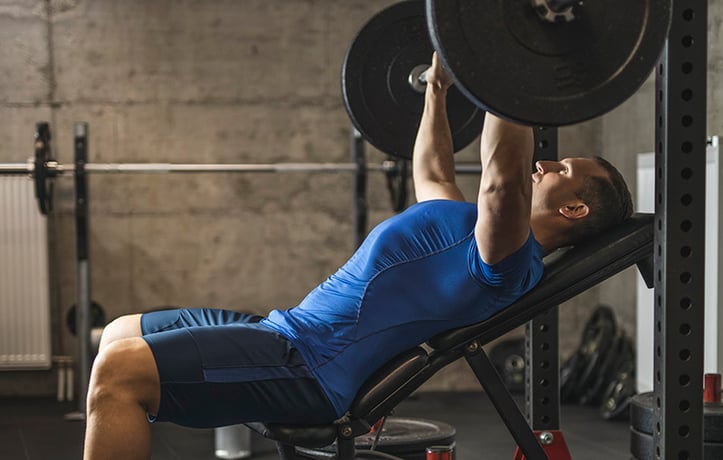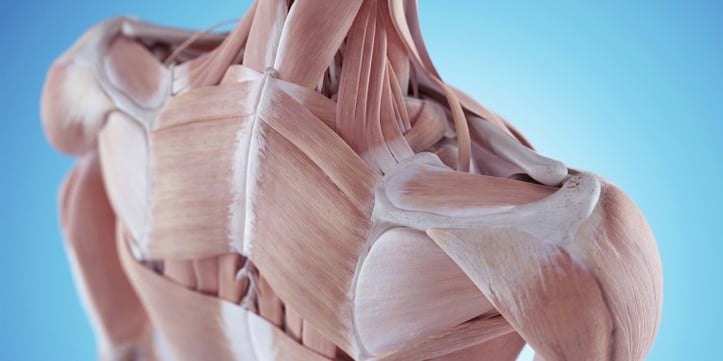
Introduction
The bench press is a staple exercise in many strength training routines. However, for some individuals, it can lead to elbow pain, often referred to as 'lifter's elbow'. This blog post will delve deep into the reasons behind this pain and provide you with practical modifications to avoid it, ensuring a safer and more effective bench press experience.
Understanding the Bench Press and Elbow Pain
The Science of the Bench Press
The bench press is a compound exercise that primarily targets the chest, shoulders, and triceps. When performed correctly, it activates multiple muscle groups simultaneously, leading to strength gains and muscle development. According to the American Council on Exercise (ACE), the bench press engages the pectoralis major, anterior deltoids, and triceps brachii, among other muscles. As you lower the weight towards your chest, the muscles eccentrically contract, and as you press the weight back up, they concentrically contract. This alternating pattern of contraction and relaxation is what leads to muscle growth and strength improvements over time. However, if the form is incorrect or there are underlying issues, it can put undue stress on the elbows.
Causes of Elbow Pain
- Incorrect Form: One of the most common causes of elbow pain during the bench press is improper form. If the elbows are flaring out too much, it can place excessive stress on the elbow joint. The elbows should ideally be at a 45-degree angle from the body. A study published in the Journal of Strength and Conditioning Research (JSCR) found that when the elbows are flared, there is a significant increase in the load on the elbow joint, which can lead to pain and potential injury over time.
- Weak Muscles: Weakness in the muscles surrounding the elbow, such as the triceps and forearm muscles, can also contribute to elbow pain. These muscles help stabilize the elbow joint during the bench press. If they are not strong enough, the joint may be more susceptible to injury. For example, if the triceps are weak, the elbow may not be able to properly control the descent of the weight, leading to a jarring effect on the joint.
- Overuse: Repeating the bench press too frequently without adequate rest can cause overuse injuries. The elbow joint needs time to recover and repair between workouts. According to the National Academy of Sports Medicine (NASM), overuse injuries are common in weightlifting and can be prevented by allowing sufficient rest and recovery time.
- Inadequate Warm-up: Skipping a proper warm-up can also lead to elbow pain. A good warm-up increases blood flow to the muscles and joints, making them more flexible and less prone to injury. A study in Medicine & Science in Sports & Exercise (MSSE) showed that athletes who warmed up properly before weightlifting had a lower incidence of injuries, including elbow pain.
Modifications to Avoid Elbow Pain
Adjust Your Grip
- Narrower Grip: A narrower grip can reduce the stress on the elbows. When you use a narrower grip, the elbows are more likely to stay in a more neutral position. This helps distribute the load more evenly across the chest and shoulders, rather than concentrating it on the elbows. For example, if you normally grip the bar with your hands shoulder-width apart, try reducing the width by a few inches and see how it feels.
- Grip Variations: Experiment with different grip variations such as a neutral grip (palms facing each other) or a reverse grip (palms facing up). These variations can place different stresses on the muscles and joints, potentially reducing elbow pain. A study in the Journal of Sports Science & Medicine found that some individuals experienced less elbow pain when using a neutral grip during the bench press.
Change Your Elbow Position
- Keep Elbows Close to Body: As mentioned earlier, keeping the elbows at a 45-degree angle from the body can significantly reduce elbow pain. This position helps maintain a more stable and balanced movement during the bench press. You can practice this by imagining that you are trying to keep a small ball tucked under your armpits as you lower and raise the weight.
- Avoid Flaring Elbows: Flaring the elbows outwards can put excessive strain on the elbow joint. Be conscious of your elbow position throughout the movement and make adjustments as needed. If you find it difficult to keep your elbows in the correct position, you can try using a bench with armrests to help guide your movement.
Use Different Equipment
- Incline Bench: Using an incline bench can change the angle of the bench press and reduce the stress on the elbows. The incline position places more emphasis on the upper chest muscles, which can take some of the load off the elbows. A study in the Journal of Strength and Conditioning Research showed that individuals who used an incline bench press reported less elbow pain compared to those who used a flat bench.
- Smith Machine: The Smith machine provides a more stable and guided movement, which can be beneficial for those with elbow pain. It can help you maintain a more consistent form and reduce the risk of injury. However, it's important to note that the Smith machine may not provide the same level of functional movement as a free-weight bench press, so it's a good idea to alternate between the two.
Strengthen the Surrounding Muscles
- Triceps Exercises: Incorporate triceps-specific exercises into your routine to strengthen the muscles around the elbow. Exercises such as triceps extensions, dips, and skull crushers can help improve triceps strength and stability. A strong triceps can better support the elbow joint during the bench press. For example, performing triceps extensions with a dumbbell can target the long head of the triceps, which is particularly important for elbow stability.
- Forearm Exercises: Strengthening the forearm muscles can also help reduce elbow pain. Wrist curls, reverse wrist curls, and grip strengtheners are all effective exercises for the forearms. Strong forearm muscles can help improve grip strength and stability, which in turn can reduce the stress on the elbows during the bench press.
Training Plan Example
Here is a one-week training plan that incorporates the modifications discussed above to help you avoid elbow pain during the bench press:
Day 1: Chest and Triceps
- Warm-up: 5 minutes of light cardio (jumping jacks, brisk walking) and dynamic stretching (arm circles, shoulder rolls)
- Incline Bench Press: 3 sets of 8-10 reps with a narrow grip and elbows close to body
- Triceps Extensions: 3 sets of 10-12 reps
- Dips: 3 sets of 8-10 reps
- Cool-down: 5 minutes of static stretching (chest stretch, triceps stretch)
Day 2: Rest or Light Activity (e.g., yoga, walking)
Day 3: Back and Biceps
- Warm-up: 5 minutes of light cardio and dynamic stretching
- Lat Pulldowns: 3 sets of 8-10 reps
- Seated Cable Rows: 3 sets of 10-12 reps
- Biceps Curls: 3 sets of 8-10 reps
- Cool-down: 5 minutes of static stretching (back stretch, biceps stretch)
Day 4: Rest or Light Activity
Day 5: Chest and Triceps (Repeat of Day 1)
Day 6: Rest or Light Activity
Day 7: Full Body Workout (Optional)
- Warm-up: 5 minutes of light cardio and dynamic stretching
- Squats: 3 sets of 8-10 reps
- Lunges: 3 sets of 10-12 reps each leg
- Shoulder Press: 3 sets of 8-10 reps
- Biceps Curls: 3 sets of 8-10 reps
- Triceps Extensions: 3 sets of 10-12 reps
- Cool-down: 5 minutes of static stretching (full body stretch)
Overcoming Plateaus
If you find that you have reached a plateau in your bench press progress, there are several strategies you can try:
- Increase the Intensity: You can increase the weight you are using, but make sure to do it gradually and maintain proper form. A small increase in weight, such as 5-10% of your current max, can help stimulate new muscle growth.
- Change the Repetition Range: If you have been doing mostly low reps (3-5), try increasing the reps to 8-12 or vice versa. This can challenge the muscles in a different way and lead to new gains.
- Incorporate Different Variations: Try different bench press variations such as the decline bench press or the dumbbell bench press. These variations can target the muscles from different angles and help break through plateaus.
Safety Precautions
- Listen to Your Body: If you experience pain during the bench press, stop immediately. Pain is a sign that something is wrong, and continuing to exercise through pain can lead to further injury.
- Use Proper Equipment: Make sure you are using a bench and barbell that are in good condition and appropriate for your skill level. Worn-out or damaged equipment can increase the risk of injury.
- Gradually Increase the Load: Don't try to lift too much weight too soon. Gradually increase the weight and intensity of your workouts over time to avoid overtraining and injury.
FAQ
Q: How long does it take for elbow pain to go away?
A: The time it takes for elbow pain to go away depends on the severity of the pain and the underlying cause. If the pain is mild and caused by a minor form issue, it may go away within a few days to a week with proper rest and modification of the bench press. However, if the pain is severe or persists for a long time, it's important to consult a healthcare professional.
Q: Can I still do the bench press if I have elbow pain?
A: It depends on the severity of the pain. If the pain is mild, you may be able to continue doing the bench press with the modifications discussed in this article. However, if the pain is severe or gets worse during the exercise, it's best to stop and rest. You may also want to consider consulting a physical therapist or a strength and conditioning professional for personalized advice.
Q: Are there any supplements that can help with elbow pain?
A: While there are no supplements that can specifically cure elbow pain, some supplements may help support joint health and reduce inflammation. For example, omega-3 fatty acids, glucosamine, and chondroitin have been shown to have anti-inflammatory properties and may be beneficial for joint health. However, it's important to note that supplements are not a substitute for proper nutrition and exercise, and you should always consult a healthcare professional before starting any new supplement regimen.
Conclusion
Elbow pain during the bench press can be a frustrating issue, but with the right modifications and strategies, it can often be avoided. By understanding the causes of elbow pain, making the appropriate adjustments to your form and equipment, and strengthening the surrounding muscles, you can continue to enjoy the benefits of the bench press without the discomfort. Remember to listen to your body, take proper safety precautions, and gradually increase the intensity of your workouts. From today, start implementing these modifications into your bench press routine and feel the difference!
So, don't let elbow pain hold you back from achieving your fitness goals. Try these modifications and get back to a pain-free bench press!

Fit vs Fat: Decoding Health's True Ruler

Pump Up Your Heart: Science-Driven Weight Loss

Wellness Technology: Your Path to Sustainable Weight Loss

A Sensible Guide to Dietary New Year's Resolutions

Prevent Shoulder and Rotator Cuff Injuries with Corrective Exercises

Overcome Fitness Plateaus: 4 Tips for Success

10 x 10 Thanksgiving Day Circuit: A Fitness Guide

Unleash Your Fitness Potential with Kit Rich's Training Secrets

The Future of Fitness: A Guide for Beginners to Intermediates

